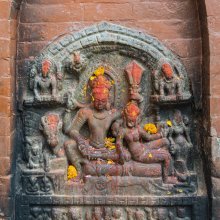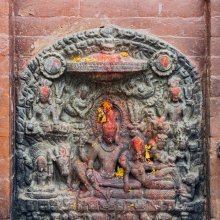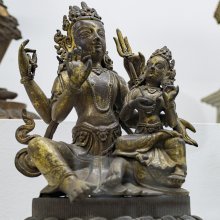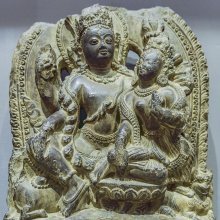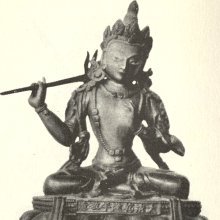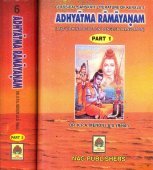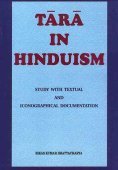Uma, Umā, Ūma, Unma: 36 definitions
Introduction:
Uma means something in Buddhism, Pali, Hinduism, Sanskrit, Jainism, Prakrit, the history of ancient India, Marathi, Hindi, biology, Tamil. If you want to know the exact meaning, history, etymology or English translation of this term then check out the descriptions on this page. Add your comment or reference to a book if you want to contribute to this summary article.
Images (photo gallery)
(+23 more images available)
In Hinduism
Shaktism (Shakta philosophy)
Source: Wisdom Library: Śāktism1) Umā (उमा) is a name of Pārvatī.—One of the female offspring from Mahāsarasvatī (sattva-form of Mahādevī). Mahāsarasvatī is one of the three primary forms of Devī, the other two being Mahālakṣmī and Mahākālī. Not to be confused with Sarasvatī, Mahāsarasvatī is a more powerful cosmic aspect (vyaṣṭi) of Devi and represents the guṇa (universal energy) named sattva. Also see the Devī Māhātmya, a Sanskrit work from the 5th century, incorporated into the Mārkaṇḍeya-Purāṇa.
2) Umā (उमा, “splendour, fame”):—Name of one of the sixty-four mātṛs to be worshipped during Āvaraṇapūjā (“Worship of the Circuit of Goddesses”, or “Durgā’s Retinue”), according to the Durgāpūjātattva. They should be worshipped with either the five upācāras or perfume and flowers.
Her mantra is as follows:
ॐ उमायै नमः
oṃ umāyai namaḥ.
3) Umā (उमा, “the peace of the night”).—One of the names of the Goddess, Devī, who is regarded as the female principle of the divine; the embodiement of the energies of the Gods.
Source: Google Books: ManthanabhairavatantramUmā (उमा) refers to the Goddess (Śakti) (of the sixth of seven births before attaining liberation) according to the Janmasūtra (cf. the second recension of the Yogakhaṇḍa of the Manthānabhairavatantra).—The six beginning with the Buddhists and ending with the Śaivites are in the fettered state (paśubhāva). The seventh that has come into being is the House (veśman) of the Yoginī whose sign is liberation. In the first one Tārā is the goddess (śakti) and Ambikā in the second. Gāyatrī is (the form of the goddess) in the third (birth) and Lakṣmī in the fourth. In the fifth she is Rājñī and is said to be Umā in the sixth. In the seventh she is Khañjī who has descended in each Age.
Note: Umā received the name Bhadrakālī and has two bodies in this the fourth age (yuga) according to the Jayadrathayāmala 1.9.359cd-361. (In one body) she is accompanied by Kṛṣṇa and (in the other) she is black and brown and is the (veritable embodiment of the) destruction of (the demon) Mahiṣa and so is Durgā, Vindhyavāsinī (‘she who lives in the Vindhyas’). She with a beautiful waist came down to grace (her) devotees.
Source: Brill: Śaivism and the Tantric Traditions (shaktism)Umā (उमा) is another name for Goddess Nityā, according to the King Vatsarāja’s Pūjāstuti called the Kāmasiddhistuti (also Vāmakeśvarīstuti), guiding one through the worship of the Goddess Nityā.—Accordingly, “[...] O mother! Even the kings of gods bow to the feet of those men who have acquired a drop of the grace of seeing you. [...] Mindful men call you Kledanī, Kulakuṇḍalinī, Kā, Nityā, Nīti, Nau, Nāvikā, Vidyā, Saṃvid, Vīśvamayī, Umā, Kāmeśvarī, and Kamalā”.

Shakta (शाक्त, śākta) or Shaktism (śāktism) represents a tradition of Hinduism where the Goddess (Devi) is revered and worshipped. Shakta literature includes a range of scriptures, including various Agamas and Tantras, although its roots may be traced back to the Vedas.
Shaivism (Shaiva philosophy)
Source: Manblunder: Sri Rudram 8.1-9Umā (उमा):—She is the wife of Maheśvara and is known as Umā Maheśvara. She was born to Himavān, the king of mountains and his wife Mena. She started Her penance at the age of five to attain Maheśvara (Śiva) as Her husband. Śiva sūtra (I.13) says Icchā śaktir umā kumārī. Here Umā means splendour of Śiva. One’s will power in constant commune with Śiva is also known as Umā.
Umā is the combination of three letters of OM – U + M + A, the praṇava. U refers to creation, M refers to destruction and A refers to sustenance. Therefore Umā also means the three acts of the Brahman.
Liṅga Purāṇa further says
“The goddess born of Rudra’s body rebuked Dakṣa and was born as Umā, the daughter of Himavān. She is bowed to, by all the worlds. Let her try to captivate the mind of Rudra by means of her beauty. Through their union Lord Skanda will be born.”

Shaiva (शैव, śaiva) or Shaivism (śaivism) represents a tradition of Hinduism worshiping Shiva as the supreme being. Closely related to Shaktism, Shaiva literature includes a range of scriptures, including Tantras, while the root of this tradition may be traced back to the ancient Vedas.
Pancaratra (worship of Nārāyaṇa)
Source: Wisdom Library: PāñcarātraUmā (उमा, “tranquillity, quiet”):—One of the twenty-four emanations of Lakṣmī accompanying Nārāyaṇa. This particular manifestation couples with his counterpart form called Janārdana and together they form the eighteenth celestial couple. Lakṣmī represents a form of the Goddess (Devī) as the wife of Viṣṇu, while Nārāyaṇa represents the personification of his creative energy, according to the Pāñcarātra literature.
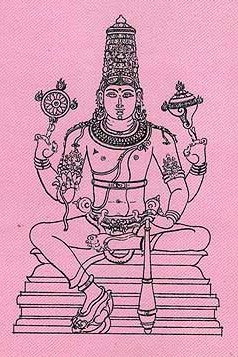
Pancaratra (पाञ्चरात्र, pāñcarātra) represents a tradition of Hinduism where Narayana is revered and worshipped. Closeley related to Vaishnavism, the Pancaratra literature includes various Agamas and tantras incorporating many Vaishnava philosophies.
Purana and Itihasa (epic history)
Source: archive.org: Nilamata Purana: a cultural and literary studyUmā (उमा) refers to a deity that was once worshipped in ancient Kashmir (Kaśmīra) according to the Nīlamatapurāṇa.—Of Śiva’s female-consort Umā, the Nīlamata speaks so highly as to give her a position higher than that of Śiva. The land of Kaśmīra is described as her material manifestation and she is further stated to have taken the form of Kaśmīra’s most famous river Vitastā.
Daughter of the mountain Himālaya, she is stated to have been originally blue-complexioned but became fair after performing penance on a mountain peak later named as Gaurīśikhara. Reference to her marriage is also made and her association with Śiva, it is said, has made her purer. Her worship is prescribed on various occasions under different names such as Durgā, Śyāmā, Satī, Bhadrakālī etc. Vegetables, fruits, roots, meat, various kinds of drinks, lamps, jewels, garlands, clothes, incense etc. are offered to her.
Source: archive.org: Puranic EncyclopediaUmā (उमा).—Pārvatī. (For details see under Pārvatī).
Source: archive.org: Shiva Purana - English Translation1) Umā (उमा) or Umāsaṃhitā refers to one of the seven books (saṃhitās) of the Śiva-purāṇa, according to the Śivapurāṇa-māhātmya 1.30-34.—“[...] This work consists of twenty-four thousand verses divided into seven saṃhitās (compendiums) [viz., umā-saṃhitā]. The three kinds of Devotion [(1) by meditation, (2) recital of prayer and (3) acts of worship and service] are fully explained in it. It must be listened to with great respect. [...] This divine Purāṇa of seven saṃhitās and called after Śiva stands on an equal footing with Brahman (i.e. Vedic Texts) and accords an achievement that is superior to everything else. He who reads the entire Śivapurāṇa without omitting any of the seven saṃhitās can be called a Jīvanmukta (a living liberated soul)”.
2a) Umā (उमा) is used as epithet of the Goddess (Devī), who incarnated as Satī, in the Śivapurāṇa 2.2.14. Accordingly as Brahmā narrated to Nārada:—“[...] Then at their bidding, the delighted Dakṣa named her Umā since she inherited good qualities and was greatly admired. Her other names in the world were assigned afterwards. They are auspicious and quell miseries in particular”.
2b) Umā (उमा) was named so because “she was prevented from going to forest by Menā” [derived from ‘u’ ‘mā’—‘O (child) do not (practise austerities)’], according to the Śivapurāṇa 2.3.22 (“Description of Pārvatī’s penance”).—Accordingly, after Menā spoke to Pārvatī: “Thus, in various ways, the daughter was dissuaded by her mother. But she did not find any pleasure except in propitiating Śiva. Pārvatī acquired the name Umā since she was prevented from going to forest by Menā and forbidden to perform penance. O sage, on realising that Pārvatī was quite dejected, Menā, the beloved of the mountain, permitted her to perform penance. [...]”.
Source: Cologne Digital Sanskrit Dictionaries: The Purana Index1a) Umā (उमा).—Worshipped for a happy family.1 Her splendour.2 Also known as Ambikā; also Rudrāṇī.3 In the forest of Sukumāra.4 Consort of Śiva, also Gaurī; originally Dākṣāyanī, daughter of Menā and Himavān. Original name Aparṇā. Her garden: a śakti:5 The world of: adhidevatā for the planet Soma.6 Festivities at her birth.7 Going with her father to Śiva's house, they met Rati weeping on the way. She said that Śiva had burnt down her husband. On this Umā's father did not like the idea of giving his daughter to such an ill-tempered person. Umā requested permission to do penance and was allowed. Indra at this time thought of the seven sages to bring about Śiva's marriage with Umā. The sages were satisfied of her steadfast love to Śiva and had his consent for the marriage; celestial women dressed Umā, as also the god Śiva; amidst divine music, the couple went to the city of Mahāgirinagara and Brahmā officiated as priest: After the marriage they left for Mandaragiri.8 Once Umā made a doll with elephant face and dropped it in the Ganges. It became a huge figure and was claimed as son by Umā and the Ganges respectively.9 Then Umā grew a tender Aśoka plant when Bṛhaspati and others told her that she would have a real son and that trees and dolls were no satisfaction;10 once she heard a yell of noise and was told of the play engaged in by Gaṇas, and then her eyes attracted Vīraka. She expressed to Śiva for a son like Vīraka. Śiva asked her to have him as her child. He was sent for and nursed by Umā.11 Touched by Goddess of Night, she became black in colour. Śiva found fault with her and after reproaching him with his past deeds, she left him for penance. Vīraka appealed to her when she said she would return as Gaurī. She asked Vīraka to see that no lady entered her harem. Meanwhile Āḍi, son of Andhakāsura entered Śiva's abode in the guise of Umā but was slain by Śiva. Hearing from Vāyu that a lady entered her home, she cursed Vīraka to be born on the earth; out of her rage came out a lion which Brahmā gave to the Goddess of Night, who was asked to leave Umā for the Vindhya hills. Now Umā became Gaurī and entered Śiva's abode when Vīraka stopped her, as he did not at first recognise her. Convinced of his mother's identity, he requested her to recall her curse and was assured of a place in Devagaṇa.12 While Umā was sporting with Śiva, Agni entered the harem in the form of a parrot. Noticing this Umā left the bed and Śiva made Agni drink his vīrya. Out of the scattered vīrya, there sprang up a beautiful pond where the six Pleiades bathed and took water in a lotus leaf. Blessed by them the Devī got the garbha and out of her left side came out Subrahmaṇya.13 Going through the udyāna again Śiva spoke to her of the greatness of Benares.14 Satī in previous birth.15
- 1) Bhāgavata-purāṇa II. 3. 7.
- 2) Ib. VIII. 7. 33; VI. 17. 36.
- 3) Ib. VIII. 18. 17; III. 12. 13.
- 4) Ib. IX. 1. 25; XII. 10. 4.
- 5) Brahmāṇḍa-purāṇa II. 25. 17; 26. 44; III 9. 1; 10. 13 and 26; 41. 17 and 55; 60. 24 and 27; IV. 44 84; Matsya-purāṇa 13. 18-9; 23. 5; Vāyu-purāṇa 71. 2-5.
- 6) Matsya-purāṇa 84. 9; 93. 13; 132. 18.
- 7) Matsya-purāṇa 154. 93-108.
- 8) Matsya-purāṇa 154. 276-496.
- 9) Matsya-purāṇa 154. 502-505.
- 10) Matsya-purāṇa 154. 506-510.
- 11) Matsya-purāṇa 154. 522-555.
- 12) Matsya-purāṇa 154. 588; chap. 15558.
- 13) Matsya-purāṇa 158. 24-48; Vāyu-purāṇa 72 (whole).
- 14) Matsya-purāṇa 180. 20-79; 181. 6-8; 191. 113; 193. 46.
- 15) Vāyu-purāṇa 30. 71; 54. 20; 55. 42; Brahmāṇḍa-purāṇa II. 13. 77.
1b) The goddess enshrined at Viṅāyaka.*
- * Matsya-purāṇa 13. 41.
Umā (उमा) is a name mentioned in the Mahābhārata (cf. IX.44.12) and represents one of the many proper names used for people and places. Note: The Mahābhārata (mentioning Umā) is a Sanskrit epic poem consisting of 100,000 ślokas (metrical verses) and is over 2000 years old.

The Purana (पुराण, purāṇas) refers to Sanskrit literature preserving ancient India’s vast cultural history, including historical legends, religious ceremonies, various arts and sciences. The eighteen mahapuranas total over 400,000 shlokas (metrical couplets) and date to at least several centuries BCE.
Kavya (poetry)
Source: Wisdom Library: KathāsaritsāgaraUmā (उमा) is one of the epithets of Durgā, according to the Kathāsaritsāgara, chapter 53. Accordingly, as Vīravara praised Durgā: “... thou art the principle of life in creatures; by thee this world moves. In the beginning of creation Śiva beheld thee self-produced, blazing and illuminating the world with brightness hard to behold, like ten million orbs of fiery suddenly produced infant suns rising at once, filling the whole horizon with the circle of thy arms, bearing a sword, a club, a bow, arrows and a spear. And thou wast praised by that god Śiva in the following words ... [Umā, etc...]”.
Also, “... when Skanda, and Vasiṣṭha, and Brahmā, and the others heard thee praised, under these [eg., Umā] and other titles, by Śiva well skilled in praising, they also praised thee. And by praising thee, O adorable one, immortals, Ṛṣis and men obtained, and do now obtain, boons above their desire. ”
The Kathāsaritsāgara (‘ocean of streams of story’), mentioning Umā, is a famous Sanskrit epic story revolving around prince Naravāhanadatta and his quest to become the emperor of the vidyādharas (celestial beings). The work is said to have been an adaptation of Guṇāḍhya’s Bṛhatkathā consisting of 100,000 verses, which in turn is part of a larger work containing 700,000 verses.
Source: Shodhganga: A critical appreciation of soddhalas udayasundarikathaUmā (उमा), the consort of Śiva has heen referred to hy the poet under several names, like Girīndraduhitā, Adrisutā, Pārvatī, Ambikā, Bhavāni and Gaurī. He has also referred to her pañcāgni penance.

Kavya (काव्य, kavya) refers to Sanskrit poetry, a popular ancient Indian tradition of literature. There have been many Sanskrit poets over the ages, hailing from ancient India and beyond. This topic includes mahakavya, or ‘epic poetry’ and natya, or ‘dramatic poetry’.
Shilpashastra (iconography)
Source: Shodhganga: The significance of the mūla-beras (śilpa)Umā is the name of deity found depicted near Maṅgalāmbikai in the Adi Kumbeswarar Temple (Ādi Kumbheśvara) in Kumbakonam (Kumbhakonam), representing a sacred place for the worship of Śiva.—Umā is in standing posture with the upper right hand holding aṅkuśa and the upper left hand holding pāśa. The lower right hand is in abhaya-hasta and the lower left hand is in urū-hasta.
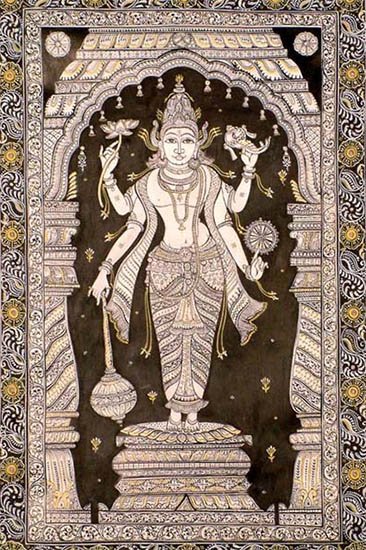
Shilpashastra (शिल्पशास्त्र, śilpaśāstra) represents the ancient Indian science (shastra) of creative arts (shilpa) such as sculpture, iconography and painting. Closely related to Vastushastra (architecture), they often share the same literature.
General definition (in Hinduism)
Source: Wisdom Library: Hinduism1) Umā (उमा)—One of the eleven wives of Rudra, called a Rudrāṇī.
2) Umā means ‘knowledge,’ and speak of Umā as the impersonation of ‘divine knowledge’, according to the commentary on the Kena-upanishad.
3) In the Rāmāyana, Umā is said to be the daughter of Himavat and Mena; the two forms of Lima and Pārvati
Source: Sacred Texts: Hindu Mythology, Vedic and PuranicUmā is the name by which the consort of Siva is first known. In the sacred books she appears in many forms, and is known by many names; but as there are legends giving the circumstances connected with the names and forms more generally known, these will be given as far as possible in chronological order. When Devi (the goddess) appears as Umā, she is said to be the daughter of Daksha, a son of Brahmā. Her father was at first very unwilling that his daughter should marry a mendicant, but his scruples were overcome by the persuasion of Brahmā. As Siva is styled Mahādeva, Umā is frequently called simply Devi.
In Buddhism
Tibetan Buddhism (Vajrayana or tantric Buddhism)
Source: academia.edu: A Critical Study of the Vajraḍākamahātantrarāja (II)Umā (उमा) refers to one the twenty-four Horā (astronomical) Goddess to be invoked during pūjā (ritual offering) in Tantric Buddhism, according to the 9th-century Vajraḍākatantra chapter 18.61-74. [...] A Yogin, putting a vessel in the left side of him, offers various things together with raw flesh, fish, immortal nectar (pañcāmṛta). Then the Yogin invites Goddesses to please them with nectar—five Ḍākinīs and twenty-four Goddesses [viz., Umā] come to the Yogin’s place, forming a maṇḍala.

Tibetan Buddhism includes schools such as Nyingma, Kadampa, Kagyu and Gelug. Their primary canon of literature is divided in two broad categories: The Kangyur, which consists of Buddha’s words, and the Tengyur, which includes commentaries from various sources. Esotericism and tantra techniques (vajrayāna) are collected indepently.
Mahayana (major branch of Buddhism)
Source: archive.org: Bulletin of the French School of the Far East (volume 5)Uma (उम) is the name of a Kinnara appointed as one of the Divine protector deities of Kosala, according to chapter 17 of the Candragarbha: the 55th section of the Mahāsaṃnipāta-sūtra, a large compilation of Sūtras (texts) in Mahāyāna Buddhism partly available in Sanskrit, Tibetan and Chinese.—In the Candragarbhasūtra, the Bhagavat invites all classes of Gods and Deities to protect the Law [dharma?] and the faithful in their respective kingdoms of Jambudvīpa [e.g., the Kinnara Uma in Kosala], resembling the time of the past Buddhas.

Mahayana (महायान, mahāyāna) is a major branch of Buddhism focusing on the path of a Bodhisattva (spiritual aspirants/ enlightened beings). Extant literature is vast and primarely composed in the Sanskrit language. There are many sūtras of which some of the earliest are the various Prajñāpāramitā sūtras.
In Jainism
General definition (in Jainism)
Source: Wisdom Library: JainismUmā (उमा) is the mother of Dvipṛṣṭha: the second Vāsudeva (“violent heroes”) according to both Śvetāmbara and Digambara sources. Since they enjoy half the power of a Cakravartin (universal monarch) they are also known as Ardhacakrins. Jain legends describe nine such Vāsudevas usually appearing together with their “gentler” twins known as the Baladevas. The legends of these twin-heroes usually involve their antagonistic counterpart known as the Prativāsudevas (anti-heroes).
The stories of queen Umā, king Brahma and their son, Dvipṛṣṭha are related in texts such as the Triṣaṣṭiśalākāpuruṣacarita (“the lives of the sixty-three illustrious persons”), a twelfth-century Śvetāmbara work by Hemacandra.
Source: archive.org: TrisastisalakapurusacaritraUmā (उमा) refers to one of two wifes of king Brahmā from Dvārakā, according to chapter 4.2 [vāsupūjya-caritra] of Hemacandra’s 11th century Triṣaṣṭiśalākāpuruṣacaritra: an ancient Sanskrit epic poem narrating the history and legends of sixty-three illustrious persons in Jainism.
Accordingly:—“Now there is a city named Dvārakā, the face-ornament of Surāṣṭra, the base of its wall washed by the waves of the western ocean. Its king was Brahmā, whose strength was undulled, by whom everyone was subdued and repressed, like a rival of Jiṣṇu (Indra). Subhadrā and Umā were his wives, the most important of his harem, like the Gaṅgā and the Sindhu of the Lavaṇa Ocean. Brahmā enjoyed happily sensuous pleasures with these two wives, like Manmatha with Rati and Prīti. [...]”.

Jainism is an Indian religion of Dharma whose doctrine revolves around harmlessness (ahimsa) towards every living being. The two major branches (Digambara and Svetambara) of Jainism stimulate self-control (or, shramana, ‘self-reliance’) and spiritual development through a path of peace for the soul to progess to the ultimate goal.
India history and geography
Source: archive.org: Geography in Ancient Indian inscriptionsUmā (उमा) is the name of a river found in India.—It is more or less certain that the Umā is none else than the Wunnā. The river formed the eastern boundary of the donated village Kothuraka, whose site seems to be occupied by Mangaon on the right bank of Wunnā.

The history of India traces the identification of countries, villages, towns and other regions of India, as well as mythology, zoology, royal dynasties, rulers, tribes, local festivities and traditions and regional languages. Ancient India enjoyed religious freedom and encourages the path of Dharma, a concept common to Buddhism, Hinduism, and Jainism.
Biology (plants and animals)
Source: Google Books: CRC World Dictionary (Regional names)1) Uma in India is the name of a plant defined with Abrus precatorius in various botanical sources. This page contains potential references in Ayurveda, modern medicine, and other folk traditions or local practices It has the synonym Glycine abrus L.) (Latin, relating to prayer (among others).
2) Uma is also identified with Calophyllum inophyllum It has the synonym Calophyllum calaba Jacq. (etc.).
3) Uma in Nigeria is also identified with Marantochloa congensis.
4) Uma is also identified with Marantochloa cuspidata It has the synonym Clinogyne arcta Stapf (etc.).
5) Uma is also identified with Marantochloa filipes It has the synonym Clinogyne oligantha (K. Schumann) K. Schum. (etc.).
6) Uma is also identified with Marantochloa leucantha It has the synonym Donax ugandensis K. Schum. (etc.).
7) Uma is also identified with Marantochloa purpurea It has the synonym Clinogyne schweinfurthiana (O. Kuntze) K. Schum. (etc.).
8) Uma in North America is also identified with Corylus americana It has the synonym Corylus americana f. missourensis (A. DC.) Fernald (etc.).
Example references for further research on medicinal uses or toxicity (see latin names for full list):
· Isis (1828)
· Humphry Marshall (1722–1801), (1722)
· Revue de zoologie et de botanique africaines (1932)
· Botanische Jahrbücher für Systematik, Pflanzengeschichte und Pflanzengeographie (1912)
· Bulletin de la Société Botanique de France (1908)
· Fl. W. Trop. Afr. (1936)
If you are looking for specific details regarding Uma, for example pregnancy safety, side effects, extract dosage, diet and recipes, chemical composition, health benefits, have a look at these references.

This sections includes definitions from the five kingdoms of living things: Animals, Plants, Fungi, Protists and Monera. It will include both the official binomial nomenclature (scientific names usually in Latin) as well as regional spellings and variants.
Languages of India and abroad
Marathi-English dictionary
Source: DDSA: The Molesworth Marathi and English Dictionaryumā (उमा).—a Simple, plain, unlearned. Ex. āpaṇa marāṭhī umēṃ māṇūsa āpaṇājavaḷa dākhalā nāhīṃ.
Marathi is an Indo-European language having over 70 million native speakers people in (predominantly) Maharashtra India. Marathi, like many other Indo-Aryan languages, evolved from early forms of Prakrit, which itself is a subset of Sanskrit, one of the most ancient languages of the world.
Sanskrit dictionary
Source: DDSA: The practical Sanskrit-English dictionaryUma (उम).—
1) A town.
2) A wharf.
Derivable forms: umaḥ (उमः).
--- OR ---
Umā (उमा).—[oḥ śivasya mā lakṣmīriva, uṃ śivaṃ māti manyate patitvena mā-ka vā Tv.]
1) Name of the daughter of Himavat and Menā, and wife of Śiva; Kālidāsa thus derives the name :उ मेति (u meti) (oh do not, scil. practise penance) मात्रा तपसो निषिद्धा पश्चादुमाख्यां सुमुखी जगाम (mātrā tapaso niṣiddhā paścādumākhyāṃ sumukhī jagāma) Kumārasambhava 1.26; उमावृषाङ्कौ (umāvṛṣāṅkau) R.3.23.
2) Light, splendour.
3) Fame, reputation.
4) Tranquility, calmness.
5) Night.
6) Turmeric (haridrā).
7) Flax (atasī).
--- OR ---
Ūma (ऊम).—a. Protecting,
-maḥ Ved. A good friend, an affectionate companion.
Source: Cologne Digital Sanskrit Dictionaries: Shabda-Sagara Sanskrit-English DictionaryUma (उम).—m.
(-maḥ) 1. A city, a town. 2. A wharf, a landing place. f.
(-mā) 1. A name of the goddess Parvati or Durga. 2. Light, splendor. 3. Fame, reputation. 4. Turmeric. 5. Flax, (Linum utilatissimum.) 6. Quiet, tranquillity. E. u particle of calling, and mā prohibition; i. e. “Practise not austerities,” the exclamation addressd to Durga by her mother: in the other, senses it may be derived from mā to measure, or mā lustre.
--- OR ---
Ūma (ऊम).—ind. An interjection of, 1. Interrogation. 2. Anger. 3. Reproach, abuse. 4. Arrogance. n.
(-maṃ) A city. E. av to preserve, &c. man Unadi aff.
Source: Cologne Digital Sanskrit Dictionaries: Benfey Sanskrit-English DictionaryUmā (उमा).—f. Pārvatī, or Durgā, the wife of Śiva, [Rāmāyaṇa] 1, 36, 15.
Source: Cologne Digital Sanskrit Dictionaries: Cappeller Sanskrit-English DictionaryUmā (उमा).—[feminine] flax; [Name] of the daughter of Himavant, the wife of Śiva-Rudra.
--- OR ---
Ūma (ऊम).—[masculine] protector, friend, companion.
Source: Cologne Digital Sanskrit Dictionaries: Monier-Williams Sanskrit-English Dictionary1) Unmā (उन्मा):—[=un-mā] 1. un-mā (ud- √3. mā).
2) [v.s. ...] 2. un-mā f. measure (of altitude), [Vājasaneyi-saṃhitā; Maitrāyaṇī-saṃhitā]
3) Uma (उम):—m. a city, town, [cf. Lexicographers, esp. such as amarasiṃha, halāyudha, hemacandra, etc.]
4) a wharf, landing-place, [cf. Lexicographers, esp. such as amarasiṃha, halāyudha, hemacandra, etc.]
5) Umā (उमा):—f. (perhaps [from] √ve, [Boehtlingk & Roth’s Sanskrit-Woerterbuch]) flax (Linum Usitatissimum), [Śatapatha-brāhmaṇa vi; Kauśika-sūtra; Pāṇini]
6) turmeric (Curcuma Longa), [Caraka]
7) Name of the daughter of Himavat (wife of the god Śiva; also called Pārvatī and Durgā; the name is said to be derived from u mā, ‘O [child], do not [practise austerities]’ the exclamation addressed to Pārvatī by her mother), [Harivaṃśa 946; Śiva-purāṇa; Kumāra-sambhava i, 26; Rāmāyaṇa; Raghuvaṃśa] etc.
8) Name of several women
9) splendour, light, [cf. Lexicographers, esp. such as amarasiṃha, halāyudha, hemacandra, etc.]
10) fame, reputation, [cf. Lexicographers, esp. such as amarasiṃha, halāyudha, hemacandra, etc.]
11) quiet, tranquillity, [cf. Lexicographers, esp. such as amarasiṃha, halāyudha, hemacandra, etc.]
12) night, [cf. Lexicographers, esp. such as amarasiṃha, halāyudha, hemacandra, etc.]
13) Ūma (ऊम):—[from ū] a m. ([Uṇādi-sūtra i, 143]) a helper, friend, companion, [Ṛg-veda; Atharva-veda v, 2, 1; 3; Aitareya-brāhmaṇa; Śāṅkhāyana-śrauta-sūtra]
14) [v.s. ...] (also) the sky, [cf. Lexicographers, esp. such as amarasiṃha, halāyudha, hemacandra, etc.]
15) [v.s. ...] n. Name of a town or place [commentator or commentary] on [Uṇādi-sūtra; Siddhānta-kaumudī]
16) b See 3. ū.
Source: Cologne Digital Sanskrit Dictionaries: Yates Sanskrit-English Dictionary1) Uma (उम):—(maḥ) 1. m. A city; a wharf.
2) Umā (उमा):—(mā) 1. f. A name of Durgā; light; fame; quiet; flax.
3) Ūma (ऊम):—Interjection of inquiry or anger. (maṃ) 1. n. A city.
Source: DDSA: Paia-sadda-mahannavo; a comprehensive Prakrit Hindi dictionary (S)Umā (उमा) in the Sanskrit language is related to the Prakrit word: Umā.
[Sanskrit to German]
Sanskrit, also spelled संस्कृतम् (saṃskṛtam), is an ancient language of India commonly seen as the grandmother of the Indo-European language family (even English!). Closely allied with Prakrit and Pali, Sanskrit is more exhaustive in both grammar and terms and has the most extensive collection of literature in the world, greatly surpassing its sister-languages Greek and Latin.
Hindi dictionary
Source: DDSA: A practical Hindi-English dictionaryUmā (उमा):—(nf) the goddess Parvati: —Lord Shiv's spouse.
...
Prakrit-English dictionary
Source: DDSA: Paia-sadda-mahannavo; a comprehensive Prakrit Hindi dictionaryUmā (उमा) in the Prakrit language is related to the Sanskrit word: Umā.
Prakrit is an ancient language closely associated with both Pali and Sanskrit. Jain literature is often composed in this language or sub-dialects, such as the Agamas and their commentaries which are written in Ardhamagadhi and Maharashtri Prakrit. The earliest extant texts can be dated to as early as the 4th century BCE although core portions might be older.
Kannada-English dictionary
Source: Alar: Kannada-English corpusŪma (ಊಮ):—[noun] = ಊಮೆ [ume].
Kannada is a Dravidian language (as opposed to the Indo-European language family) mainly spoken in the southwestern region of India.
Tamil dictionary
Source: DDSA: University of Madras: Tamil LexiconUmā (உமா) noun < umā. Crabs-eye. See குன்றி. (வைத்திய மூலிகை) [kunri. (vaithiya muligai)]
Tamil is an ancient language of India from the Dravidian family spoken by roughly 250 million people mainly in southern India and Sri Lanka.
Nepali dictionary
Source: unoes: Nepali-English DictionaryUmā (उमा):—n. Mythol. wife of Mahadeva (महादेव [mahādeva] ); Hindu goddess called Durga (दुर्ग [durga] );
Nepali is the primary language of the Nepalese people counting almost 20 million native speakers. The country of Nepal is situated in the Himalaya mountain range to the north of India.
See also (Relevant definitions)
Starts with (+237): Uma-gida, Uma-goyashi, Uma-hu, Uma-paticivacariyar, Umabhagavati, Umabharana, Umabhartri, Umabophe, Umacalanem, Umacaturthi, Umaccha, Umaccha, Umachaturthi, Umada, Umadalanem, Umadana, Umadevi, Umadhava, Umadita, Umadji.
Ends with (+913): Abhauma, Abhinuma, Adhibhauma, Adhyatmakalpadruma, Adinakusuma, Aduma, Agamakalpadruma, Agaradhuma, Agastyakusuma, Agilukumkuma, Aguma, Ajaradruma, Ajuma, Akalaguma, Akalakusuma, Akashakusuma, Akhamdaladruma, Akusuma, Alamdhuma, Alandhuma.
Full-text (+966): Umaguru, Umapati, Auma, Umavana, Umesha, Umasuta, Umakata, Mangalavrata, Oma, Unmada, Umam, Umanatha, Umasahaya, Godhuma, Shubhacara, Aumika, Bhimodari, Sunanda, Aumapata, Umas.
Relevant text
Search found 108 books and stories containing Uma, Umā, Ūma, Un-ma, Un-mā, Unma, Unmā, Umaa; (plurals include: Umas, Umās, Ūmas, mas, mās, Unmas, Unmās, Umaas). You can also click to the full overview containing English textual excerpts. Below are direct links for the most relevant articles:
Rig Veda (translation and commentary) (by H. H. Wilson)
The Skanda Purana (by G. V. Tagare)
Chapter 61 - Greatness of Lalitomāviśālākṣī (Lalitomā-viśālākṣī) < [Section 1 - Prabhāsa-kṣetra-māhātmya]
Chapter 11 - Procedure of Gaṇeśa Worship: Manifestation of Lakṣmī < [Section 1 - Kedāra-khaṇḍa]
Chapter 47 - Bṛhaspatīśvara (Bṛhaspati-īśvara) < [Section 1 - Prabhāsa-kṣetra-māhātmya]
Brihad Bhagavatamrita (commentary) (by Śrī Śrīmad Bhaktivedānta Nārāyana Gosvāmī Mahārāja)
Verse 2.4.19 < [Chapter 4 - Vaikuṇṭha (the spiritual world)]
Verse 2.1.84 < [Chapter 1 - Vairāgya (renunciation)]
Verse 2.3.115 < [Chapter 3 - Bhajana (loving service)]
Kena upanishad (Madhva commentary) (by Srisa Chandra Vasu)
Mantra 3.12 < [Book 3 - Tṛtīya-Khaṇḍa]
Madhva’s commentary of the Third Khaṇḍa < [Book 3 - Tṛtīya-Khaṇḍa]
Mantra 4.3 < [Book 4 - Caturtha-Khaṇḍa]
Garga Samhita (English) (by Danavir Goswami)
Verse 5.11.7 < [Chapter 11 - The Stories of Kubjā and Kuvalayāpīḍa]
The Agni Purana (by N. Gangadharan)
Related products
